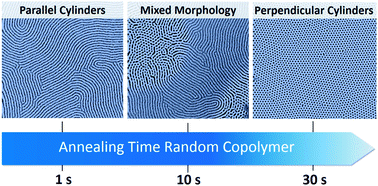Flash grafting of functional random copolymers for surface neutralization
Abstract
Tailoring surface energies is the key factor to control the orientation of nanoscopic structures in thin block copolymer (BCP) films. In the general frame of the “grafting to” approach, this paper reports on the use of Rapid Thermal Processing (RTP) technology to perform flash grafting reactions of a hydroxyl terminated poly(styrene-r-methylmethacrylate) random copolymer to the activated silicon wafer surface. The perpendicular orientation of the cylindrical morphology of an asymmetric PS-b-PMMA block copolymer is achieved when the thickness of the random copolymer layer is higher than 6.0 nm. The grafting time to achieve this thickness reduces from about 750 s, when the RTP grafting process is performed at 230 °C, to 15 s at 310 °C. For a symmetric PS-b-PMMA block copolymer, the perpendicularly oriented lamellar morphology is obtained when the random layer thickness is higher than 3.5 nm, that is after 60 s RTP grafting time at 250 °C. In addition, TGA-GC-MS analysis indicates that a chain structural reorganization, which occurs during the RTP treatment at high temperature, affords a more stable film structure without changing its surface characteristics. In conclusion, the RTP technology allows the “grafting to” approach to be successfully integrated into the next generation lithographic processes and affords the unprecedented opportunity to study the grafting of macromolecules on time scales and in temperature ranges that have never been explored before, shedding new light on the early stages and on the dynamics of these processes.


 Please wait while we load your content...
Please wait while we load your content...